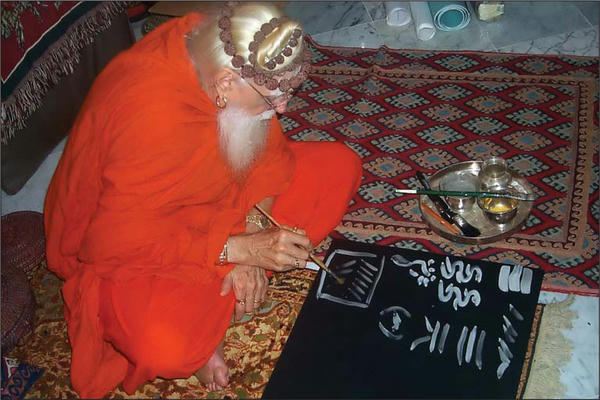
PART 6
The Seven Chakras
In his descriptions of the mamsanī maā, Gurudeva makes occasional references to the chakras, called kamshūmālingā in Shūm. This brief lexicon describing the seven chakras is presented as a reference for those wanting a simple introduction to the chakras and their spheres of influence. §
kamshūmālingā  25.18.12.04.12§
25.18.12.04.12§
1) Any of the chakras, which are nerve plexes or centers of force and consciousness within the inner bodies of man; 2) refers to all twenty-one chakras—the seven principal chakras, the seven chakras or nāḍīs above the crown of the head and the seven chakras below the mūlādhāra; 3) through transmutation, one unfolds through the seven principal kamshūmālingā maā as awareness and kuṇḍalinī break the seals of these force centers; 4) the kamshūmālingā maā may also be understood as windows of mind or consciousness through which awareness looks out or in on the phenomenal world; each window has its own influence and coloring effect on the process of perception.§
ākaiīlīsimbī  12.101.05.08.13§
12.101.05.08.13§
1) The first of the primary chakras, named mūlādhāra in Sanskrit; 2) attribute—memory, time, space; 3) located at the base of the spine; 4) color—red; planet—Mercury; element—earth; sense—smell; petals—four; pañchākshara mantra letter—na.§
rehnamtyēvūm  10.35.11.09§
10.35.11.09§
1) The second chakra, named svādhishṭhāna in Sanskrit; 2) attribute—reason; 3) located at the navel; 4) color—reddish orange; planet—Venus; element—water; sense—taste; petals—six; pañchākshara mantra letter—ma.§
bīvūmbīka  13.09.13.07§
13.09.13.07§
1) The third chakra, named maṇipūra in Sanskrit; 2) attribute—willpower; 3) located at the solar plexus; 4) color—yellow amber; planet—Mars; element—fire; sense—sight; petals—ten; pañchākshara mantra letter—śi.§
rehmtyēnalī  26.11.15.05§
26.11.15.05§
1) The fourth chakra, named anāhata in Sanskrit; 2) attribute—direct cognition; 3) located at the heart; 4) this chakra is the resting place; 5) color—smokey green; planet—Jupiter; element—air; sense—touch; petals—twelve; pañchākshara mantra letter—vā.§
kalingkasim°  07.04.07.08.140§
07.04.07.08.140§
1) The fifth chakra, named viśuddha in Sanskrit; 2) attribute—divine love; 3) located at the throat; 4) it is here where magical powers exist, and it is here that the past is dissolved and the vision of a positive, productive future is revealed; 5) color—smokey purple blue; planet—Saturn; element—ether; sense—hearing; petals—sixteen; pañchākshara mantra letter—ya. §
tyēmavūmna»  11.29.09.15.148§
11.29.09.15.148§
1) The sixth chakra, named ājñā in Sanskrit; 2) attribute—divine sight; 3) located at the third eye (between the two physical eyes); 4) relates to language and speech; 5) it is the area of the mind where, through the third eye, mystics can scan the universe; 6) it is the area where past, present and future are seen as one; 7) it is the third eye that sees all, for it is within all at every point in time; 8) only when the awareness moves into this chakra do the two petals open from deep within the chakra above, and divine sight comes; 9) color—lavender; planet—Uranus; element—mahātattva; sense—intuition; petals—two; the aum of the pañchākshara mantra.§

kamakadīīsareh  07.29.07.17.01.39.10§
07.29.07.17.01.39.10§
1) The seventh chakra, named sahasrāra in Sanskrit; 2) attribute—illumination; 3) located at the crown of the head; 4) in the area of the mind of the sahasrāra chakra in full bloom, a radiant display of lights of various pastel colors is seen; 5) it is mystically seen extending above the head as a thousand-petaled lotus made of quantums of light particles; 6) this center of divine, actinic force holds the intelligence of the inner and outer bodies; 7) its center holds the secrets of divine sight; 8) the door to the universe; 9) color—gold; planet—Neptune; element/sense—śūnya (void); petals—one thousand and eight.§
